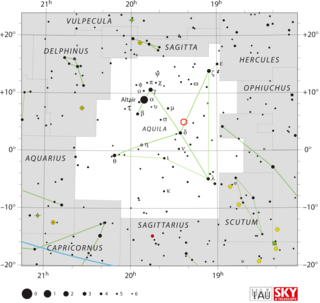
V1494 Aquilae or Nova Aquilae 1999 b was a nova which occurred during 1999 in the constellation Aquila and reached a brightness of magnitude 3.9 on 2 December 1999. making it easily visible to the naked eye. The nova was discovered with 14×100 binoculars by Alfredo Pereira of Cabo da Roca, Portugal at 18:50 UT on 1 December 1999, when it had a visual magnitude of 6.0.

AM Herculis is a binary variable star located in the constellation Hercules. This star, along with the star AN Ursae Majoris, is the prototype for a category of cataclysmic variable stars called polars, or AM Her type stars.
Z Andromedae is a binary star system consisting of a red giant and a white dwarf. It is the prototype of a type of cataclysmic variable star known as symbiotic variable stars or simply Z Andromedae variables. The brightness of those stars vary over time, showing a quiescent, more stable phase and then an active one with a more pronounced variability and stronger brightening and/or dimming.

BB Doradus or BB Dor is a cataclysmic variable, a pre-nova star, thus a close pair binary star system. It is composed of a red dwarf and a white dwarf. Observations of the white dwarf's faint but certain accretion disk are consistent with it being at ~10° inclination.

WZ Sagittae is a cataclysmic dwarf nova star system in the constellation Sagitta. It consists of a white dwarf primary being orbited by a low mass companion. The white dwarf is about 0.85 solar masses while the companion is only 0.08 solar masses. This implies that the companion is a spectral class L2 star, although this has yet to be confirmed. The distance to this system has been determined by parallax, yielding a distance of 45.1 parsecs.
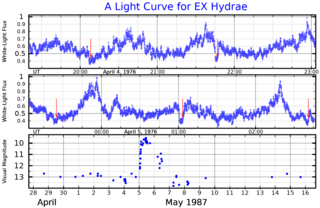
EX Hydrae is a variable star classified as an eclipsing intermediate polar-type cataclysmic variable, specifically of the DQ Herculis type. The system varies in apparent magnitude from 9.6 to 14. The system consists of a white dwarf primary and an M-type secondary, of masses of 0.4–0.7 M☉ and 0.07–0.10 M☉ respectively. The orbital period is 98.25696 minutes (0.068233846 days). The system is 65±11 parsecs distant, making EX Hya one of the closest cataclysmic variable stars. The cataclysmic outbursts appear to be caused by accretion of material from the M-star to the white dwarf.
Z Camelopardalis (Z Cam) is a cataclysmic variable star system in the northern constellation of Camelopardalis. It has an apparent visual magnitude which varies between 9.8 and 14.5. This system is the prototype star for the family of Z Camelopardalis variable stars: dwarf novae with standstills at a brightness intermediate between their maxima and minima. It may be the same bright nova that was recorded by Chinese astrologers in the autumn of 77 BCE.

SS Cygni is a variable star in the northern constellation Cygnus. It was discovered in 1896 by Louisa D. Wells, a computer working under Edward Pickering at Harvard College Observatory. It is the prototype of the subclass of dwarf novae that show only normal eruptions. It typically rises from 12th magnitude to 8th magnitude for 1–2 days every 7 or 8 weeks. The northerly declination of SS Cygni makes the star almost circumpolar from European and North American latitudes, allowing a large proportion of the world's amateur astronomers to monitor its behavior. Furthermore, since the star lies against the rich backdrop of the Milky Way band, the telescope field of view around SS Cygni contains an abundance of useful brightness comparison stars.

RZ Gruis is a nova-like binary system in the constellation Grus composed of a white dwarf and an F-type main-sequence star. It is generally of apparent magnitude of 12.3 with occasional dimming to 13.4. Its components are thought to orbit each other roughly every 8.5 to 10 hours. It belongs to the UX Ursae Majoris subgroup of cataclysmic variable star systems, where material from the donor star is drawn to the white dwarf where it forms an accretion disc that remains bright and outshines the two component stars. The system is around 1,434 light-years away from Earth; or as much as 1,770 light years based on a Gaia parallax.

BV Centauri is a cataclysmic variable binary star in the constellation Centaurus. It is a dwarf nova, and undergoes rapid increases in brightness that are recurrent with a mean period of 150 days. This period seems to have increased in the last few decades. During quiescence, its visual apparent magnitude is about 13, with variations of a few tenths of magnitude over an orbit due to differences in the star's visible surface area, brightening to a maximum magnitude of 10.7 during outbursts. From its luminosity, it is estimated that the system is about 500 parsecs (1,600 ly) away from Earth. A Gaia parallax of 2.81 mas has been measured, corresponding to about 360 pc.

TU Andromedae is a variable star of the Mira type in the constellation Andromeda. It has a spectral type of M5e and a visual magnitude which varies between extremes of 7.6 and 13.5.
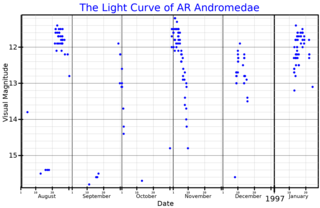
AR Andromedae is a dwarf nova of the SS Cygni type in the constellation Andromeda. Its typical apparent visual magnitude is 17.6, but increases up to 11.0 magnitude during outbursts. The outbursts occur approximately every 23 days.

DX Andromedae is a cataclysmic variable star in the constellation Andromeda. It has a typical apparent visual magnitude of 15.5 during the quiescent phase, but becomes brighter during outbursts recurring with a mean cycle length of 330 days, thus is classified as a dwarf nova of the SS Cygni type.

PX Andromedae is an eclipsing cataclysmic variable star in the constellation Andromeda. It has been classified as a SW Sextantis variable, and its apparent visual magnitude varies between 14.04 and 17.

V455 Andromedae is a dwarf nova in the constellation Andromeda. It has a typical apparent visual magnitude of 16.5, but reached a magnitude of 8.5 during the only observed outburst.

YZ Reticuli, also known as Nova Reticuli 2020 was a naked eye nova in the constellation Reticulum discovered on July 15, 2020. Previously it was known as a VY Sculptoris type object with the designation MGAB-V207.

BZ Ursae Majoris is a dwarf nova star system in the northern circumpolar constellation of Ursa Major. It consists of a white dwarf primary in a close orbit with a red dwarf. The latter star is donating mass, which is accumulating in an accretion disk orbiting the white dwarf. The system is located at a distance of approximately 505 light years from the Sun based on parallax measurements.
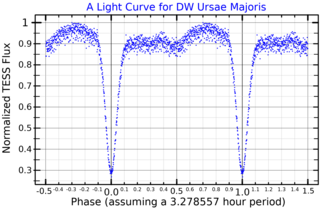
DW Ursae Majoris is an eclipsing binary star system in the northern circumpolar constellation of Ursa Major, abbreviated DW UMa. It is a cataclysmic variable of the SX Sextanis type, consisting of a compact white dwarf that is accreting matter from an orbiting companion star. The brightness of this source ranges from an apparent visual magnitude of 13.6 down to magnitude 18, which is too faint to be viewed with the naked eye. The distance to this system is approximately 1,920 light years based on parallax measurements.
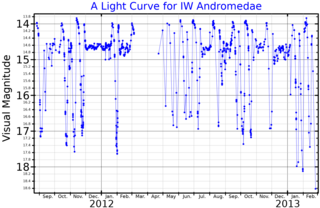
IW Andromedae is a binary star system in the northern constellation of Andromeda, abbreviated IW And. It is the prototype of a class of variable stars known as IW And variables, which is an anomalous sub-class of the Z Camelopardalis variables. The brightness of this system ranges from an apparent visual magnitude of 13.7 down to 17.3, which requires a telescope to view. The system is located at a distance of approximately 2,860 light years from the Sun based on parallax measurements.

BW Sculptoris is WZ Sge-type dwarf nova and a candidate period bouncer. The binary consists of a white dwarf and a brown dwarf donor that orbits the white dwarf every 78.23 minutes. BW Sculptoris is one of the closest and brightest cataclysmic variable stars with a brightness of magnitude16.5 and a distance of 93.3 parsecs. It also has the shortest period for any CVs known to date.


















